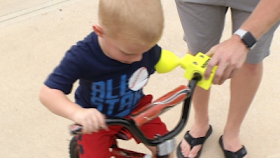Tomorrow’s Tech … Today!
[Some of this was used as content for the Program Book of
SoonerCon 24 in June 2015. Hope you like
the idea!]
****************************************************************
SUBSPACE RADIO / INSTANT COMMUNICATION
With the
comprehension of space’s immensities came the need in fiction to cope with
those distances in relation to communication.
If a spaceship is traveling at relativistic speeds, they would arrive
before any radio signals!
Le Guin
coined the term “ansible” for her take on instant communications, in 1966
(derived from the word “answerable”).
Previous versions of the same idea were Isaac Asimov’s “hyperwave relay”
and the “Dirac transmitter” (aka “beep”) proposed by James Blish in his Cities
in Flight tales. [The Dirac
Transmitter was named for quantum physicist Paul Dirac.]
The Star
Trek term “subspace radio” is more suggestive, implying that
communications can somehow detour around “normal” space, therefore sidetracking
the speed-of-light restrictions that radio waves must endure. The TNG Writer’s Manual stated that
communications could go about 100 times faster than the fastest warp-drive
vessel. In other words, your ship could
never outrun an interfering ambassador’s backseat meddling!
One observer
says, “The Heisenberg Uncertainty Principle tends to stop the use of apparent
FTL quantum effects for sending information.”
So in reality it looks as if, even with communications, the Speed of Light isn’t just a suggestion …
it’s the law!
*******************************************************************
MOOD ORGAN
That’s Philip
K Dick’s 1968 term in Do Androids Dream of Electric Sheep?
for a dial-a-mood device. It can also be
a catch-all term for any plug-in-and-drop-out concept.
The idea of
escaping it all through total immersion has been around a while. A 1929 tale “The Chamber of Life” in Amazing
Stories posited a “pleasure machine,” and many writers have examined
the concept of one person vicariously sharing another’s experiences. Sometimes this uses the memories up, so that
the originator is an empty shell (as in the 1989 New Twilight Zone
episode, “The Mind of Simon Foster”).
Larry Niven’s
creation, the droud, is a pleasure-the-brain addiction featured in his Known
Space tales.
Real-world
investigations into external manipulation of thoughts or moods can be
approached in varying ways. Wired brain
stimulation is a therapeutic tool for epilepsy or other conditions. Remote stimulation has been effected by the
use of various radio waves by CIA and other types. Some ELFs (Extremely Low Frequencies) will
cause feelings of unease or panic, or even physical sickness — the original
“brown note.”
We’re a long
way from actually being able to impact or influence moods or thoughts, except
through the grosser methods of political ads and friendly word-of-twitter. And of course, painting your room a calming
color.
**************************************************************
DUPLICATING RAY
Several SF
tales as early as the 1940s examined the disastrous effect such tech would have
on any market-based technology. Why work
for a living if you could “copy” as much gold as you want?
Of course, in
fiction things go wrong more dramatically.
DC Comics’ Bizarros arose from a malfunctioning duplicator ray, from
which arose imperfect copies of various DC characters, beginning with 1958’s Superboy
#68. Some of our more seasoned readers
may remember Htrae, the cube-shaped planet entirely populated by various
Bizarros.
But, back to
the ideal of things going right: Neal
Stephenson and others have suggested rebuilding matter using
nano-technology. It can even be argued
that the present 3-D Printer is an early step in the right direction.
After all, in January 2015 the Prez and
Vice-Prez got to inspect a (functional) 3-D-printed Shelby Cobra roadster.
Likewise, in February 2015 a headline read,
“Kansas 3-D Printing Lab Creates Prosthetics for Boy.” However, it’s probable that this will remain
only a gleam in the dreams of people who don’t understand the harsh realities
of E
= mc2. You can’t make
somethin’ from nothin’!
See you Thursday!











No comments:
Post a Comment